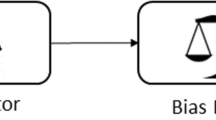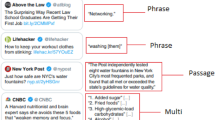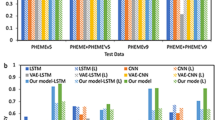Abstract
Clickbait involves creating attention-grabbing or deceptive content aimed at generate more clicks. While effective for driving online traffic, it often results in misinformation, user frustration, and a diminished experience. Therefore, promptly identifying and addressing clickbait is vital. Spoiling clickbait involves crafting concise messages that divulge the actual content, serving as a means to counter its effects. Creating brief messages that expose the genuine nature of clickbait posts is one method of countering it. The proposed model first identifies the clickbait highlighting the words using the Local Interpretable Model-Agnostic Explanations (LIME) approach which helps to mark it as clickbait. The sentences containing those highlighted words are extracted from a dataset to create a spoiler for that post. The Bilingual Evaluation Understudy (BLEU) score of 0.61 and Recall-Oriented Understudy for Gisting Evaluation (ROUGE) score of 0.72 obtained from the proposed spoiler generation model surpassed the prior state-of-the-art models.





Similar content being viewed by others
Data availability
The dataset used in this study is available: https://zenodo.org/record/6362726, https://webis.de/events/clickbait-challenge/shared-task.html.
References
Chakraborty, A., Paranjape, B., Kakarla, S., Ganguly, N. (2016). Stop clickbait: Detecting and preventing clickbaits in online news media. In: 2016 IEEE/ACM International Conference on Advances in Social Networks Analysis and Mining (ASONAM), IEEE, pp. 9–16.
Supriya, Singh, J.P., Kumar, G.: Identification of clickbait news articles using SBERT and correlation matrix. Social Network Analysis and Mining (2023).
Zhang, Y., Zhang, R., Mensah, S., Liu, X., Mao, Y. (2022). Unsupervised sentence representation via contrastive learning with mixing negatives. In: Proceedings of the AAAI Conference on Artificial Intelligence, vol. 36, pp. 11730–11738.
Shmalts, M. (2023). John boy walton at semeval-2023 task 5: An ensemble approach to spoiler classification and retrieval for clickbait spoiling. In: Proceedings of the 17th International Workshop on Semantic Evaluation (SemEval-2023), pp. 2100–2106.
Panda, I., Singh, J. P., Pradhan, G., & Kumari, K. (2024). A deep learning framework for clickbait spoiler generation and type identification. Journal of Computational Social Science, 7, 671–693.
Lundberg, S.M., Lee, S.-I.: A unified approach to interpreting model predictions. Advances in neural information processing systems 30 (2017)
Ribeiro, M.T., Singh, S., Guestrin, C. (2016). ”why should i trust you?” explaining the predictions of any classifier. In: Proceedings of the 22nd ACM SIGKDD International Conference on Knowledge Discovery and Data Mining, pp. 1135–1144.
Lipton, Z. C. (2018). The mythos of model interpretability: In machine learning, the concept of interpretability is both important and slippery. Queue, 16(3), 31–57.
Potthast, M., Köpsel, S., Stein, B., Hagen, M. (2016). Clickbait detection. In: Advances in Information Retrieval: 38th European Conference on IR Research, ECIR 2016, Padua, Italy, March 20–23, 2016. Proceedings 38, pp. 810–817. Springer.
Vorakitphan, V., Leu, F.-Y., Fan, Y.-C. (2019). Clickbait detection based on word embedding models. In: Innovative Mobile and Internet Services in Ubiquitous Computing: Proceedings of the 12th International Conference on Innovative Mobile and Internet Services in Ubiquitous Computing (IMIS-2018), pp. 557–564. Springer.
Manjesh, S., Kanakagiri, T., Vaishak, P., Chettiar, V., Shobha, G.: Clickbait pattern detection and classification of news headlines using natural language processing. In: 2017 2nd International Conference on Computational Systems and Information Technology for Sustainable Solution (CSITSS), pp. 1–5 (2017). IEEE
Glenski, M., Ayton, E., Arendt, D., Volkova, S.: Fishing for clickbaits in social images and texts with linguistically-infused neural network models. arXiv preprint arXiv:1710.06390 (2017)
Kumar, V., Khattar, D., Gairola, S., Kumar Lal, Y., Varma, V.: Identifying clickbait: A multi-strategy approach using neural networks. In: The 41st International ACM SIGIR Conference on Research and Development in Information Retrieval, pp. 1225–1228 (2018)
Sisodia, D. S. (2019). Ensemble learning approach for clickbait detection using article headline features. The International Journal of an Emerging Transdiscipline, 22, 31–44.
Shang, L., Zhang, D. Y., Wang, M., Lai, S., & Wang, D. (2019). Towards reliable online clickbait video detection: A content-agnostic approach. Knowledge-Based Systems, 182, 104851.
Kaur, S., Kumar, P., & Kumaraguru, P. (2020). Detecting clickbaits using two-phase hybrid cnn-lstm biterm model. Expert Systems with Applications, 151, 113350.
Naeem, B., Khan, A., Beg, M. O., & Mujtaba, H. (2020). A deep learning framework for clickbait detection on social network using natural language cues. Journal of Computational Social Science, 3, 231–243.
Coste, C. I., & Bufnea, D. (2021). Advances in clickbait and fake news detection using new language-independent strategies. Journal of Communications Software and Systems, 17(3), 270–280.
Patil, S., Koul, M., Chauhan, H., & Patil, P. (2021). Detecting and categorization of clickbaits. International Journal of Engineering Research and Technology (IJERT), 9(3), 1–6.
Jain, M., Mowar, P., Goel, R., Vishwakarma, D.K.: Clickbait in social media: Detection and analysis of the bait. In: 2021 55th Annual Conference on Information Sciences and Systems (CISS), pp. 1–6 (2021). IEEE
Pujahari, A., & Sisodia, D. S. (2021). Clickbait detection using multiple categorisation techniques. Journal of Information Science, 47(1), 118–128.
Probierz, B., Stefański, P., & Kozak, J. (2021). Rapid detection of fake news based on machine learning methods. Procedia Computer Science, 192, 2893–2902.
Razaque, A., Alotaibi, B., Alotaibi, M., Hussain, S., Alotaibi, A., & Jotsov, V. (2022). Clickbait detection using deep recurrent neural network. Applied Sciences, 12(1), 504.
Zhou, M., Xu, W., Zhang, W., & Jiang, Q. (2022). Leverage knowledge graph and GCN for fine-grained-level clickbait detection. World Wide Web, 25(3), 1243–1258.
Bronakowski, M., Al-khassaweneh, M., & Al Bataineh, A. (2023). Automatic detection of clickbait headlines using semantic analysis and machine learning techniques. Applied Sciences, 13(4), 2456.
Chowanda, A., Nadia, N., & Kolbe, L. M. M. (2023). Identifying clickbait in online news using deep learning. Bulletin of Electrical Engineering and Informatics, 12(3), 1755–1761.
Johnson, O., Lou, B., Zhong, J., Kurenkov, A.: Saved you a click: Automatically answering clickbait titles. arXiv preprint arXiv:2212.08196 (2022)
Maharani, N.P.I., Purwarianti, A., Aji, A.F.: Low-resource clickbait spoiling for Indonesia via question answering. arXiv preprint arXiv:2310.08085 (2023)
Bilgis, T., Bozdag, N.B., Bethard, S.: Gallagher at semeval-2023 task 5: Tackling clickbait with seq2seq models. In: Proceedings of the 17th International Workshop on Semantic Evaluation (SemEval-2023), pp. 1650–1655 (2023)
Pan, R., García-Díaz, J.A., García-Sánchez, F., Valencia-García, R.: Chick adams at semeval-2023 task 5: Using RoBERTa and DeBERTa to extract post and document-based features for clickbait spoiling. In: Proceedings of the 17th International Workshop on Semantic Evaluation (SemEval-2023), pp. 624–628 (2023)
Biecek, P., & Burzykowski, T. (2021). Explanatory model analysis: Explore, explain, and examine predictive models. CRC Press.
Papineni, K., Roukos, S., Ward, T., Zhu, W.-J.: BLEU: A method for automatic evaluation of machine translation. In: Proceedings of the 40th Annual Meeting of the Association for Computational Linguistics, pp. 311–318 (2002)
Lin, C.-Y.: Rouge: A package for automatic evaluation of summaries. In: Text Summarization Branches Out, pp. 74–81 (2004)
Zhang, T., Kishore, V., Wu, F., Weinberger, K.Q., Artzi, Y.: BERTscore: Evaluating text generation with bert. arXiv preprint arXiv:1904.09675 (2019)
Banerjee, S., Lavie, A.: METEOR: An automatic metric for machine translation evaluation with improved correlation with human judgments. In: Proceedings of the ACL Workshop on Intrinsic and Extrinsic Evaluation Measures for Machine Translation and/or Summarization, pp. 65–72 (2005)
Hagen, M., Fröbe, M., Jurk, A., Potthast, M.: Clickbait spoiling via question answering and passage retrieval. arXiv preprint arXiv:2203.10282 (2022)
Kruff, A., Tran, A.H.: Billie-newman at semeval-2023 task 5: Clickbait classification and question answering with pre-trained language models, named entity recognition and rule-based approaches. In: Proceedings of the 17th International Workshop on Semantic Evaluation (SemEval-2023), pp. 1542–1550 (2023)
Tailor, N., Mamidi, R.: Matt bai at semeval-2023 task 5: Clickbait spoiler classification via bert. In: Proceedings of the 17th International Workshop on Semantic Evaluation (SemEval-2023), pp. 1067–1068 (2023)
Sterz, H., Bongard, L., Werner, T., Poth, C., Hentschel, M.: Ml mob at semeval-2023 task 5:“breaking news: Our semi-supervised and multi-task learning approach spoils clickbait”. In: Proceedings of the 17th International Workshop on Semantic Evaluation (SemEval-2023), pp. 1818–1823 (2023)
Keller, J., Rehbach, N., Zafar, I.: Nancy-hicks-gribble at semeval-2023 task 5: Classifying and generating clickbait spoilers with RoBERTa. In: Proceedings of the 17th International Workshop on Semantic Evaluation (SemEval-2023), pp. 1712–1717 (2023)
Acknowledgements
We thank the data provider for helping us.
Funding
Not applicable.
Author information
Authors and Affiliations
Contributions
All authors have equally contributed to the manuscript.
Corresponding author
Ethics declarations
Conflict of interest
The authorsdeclare that they have no conflict of interest.
Ethical Approval
Not applicable.
Additional information
Publisher's Note
Springer Nature remains neutral with regard to jurisdictional claims in published maps and institutional affiliations.
Rights and permissions
Springer Nature or its licensor (e.g. a society or other partner) holds exclusive rights to this article under a publishing agreement with the author(s) or other rightsholder(s); author self-archiving of the accepted manuscript version of this article is solely governed by the terms of such publishing agreement and applicable law.
About this article
Cite this article
Panda, I., Singh, J.P. & Pradhan, G. Local explainability-based model for clickbait spoiler generation. J Comput Soc Sc 8, 4 (2025). https://doi.org/10.1007/s42001-024-00329-9
Received:
Accepted:
Published:
DOI: https://doi.org/10.1007/s42001-024-00329-9




